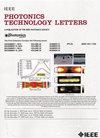Machine Learning Enhanced Single Crystal Fiber Fabrication via Laser Heated Pedestal Growth
IF 2.5
3区 工程技术
Q2 ENGINEERING, ELECTRICAL & ELECTRONIC
引用次数: 0
Abstract
This study introduces a machine learning (ML)-assisted framework for optimizing Proportional-Integral-Derivative (PID) coefficients, enabling stable, long-length single crystal fiber (SCF) fabrication via the Laser Heated Pedestal Growth (LHPG) technique. Compared with traditional curve-fitting methods, the proposed ML approach significantly enhances computational efficiency and achieves up to 20dB improvement in prediction accuracy, leading to notable improvements in SCF uniformity and achievable fiber length. The fabricated sapphire SCF demonstrates a length exceeding 3 m and an average diameter of机器学习增强单晶光纤在激光加热基座生长中的制备
本研究介绍了一种机器学习(ML)辅助框架,用于优化比例-积分-导数(PID)系数,通过激光加热基座生长(LHPG)技术实现稳定的长长度单晶光纤(SCF)制造。与传统的曲线拟合方法相比,本文提出的ML方法显著提高了计算效率,预测精度提高了20dB,从而显著改善了SCF均匀性和可实现的光纤长度。制备的蓝宝石SCF长度超过3 m,平均直径为$150~\mu $ m,波动小于$ $ pm 3~\mu $ m,验证了ML模型的有效性。此外,还提供了优化LHPG系统中PID系数的基本准则。这些结果为高质量的SCF制造提供了有价值的见解,并有望促进适用于恶劣环境传感应用的改进纤维的生产。
本文章由计算机程序翻译,如有差异,请以英文原文为准。
求助全文
约1分钟内获得全文
求助全文
来源期刊

IEEE Photonics Technology Letters
工程技术-工程:电子与电气
CiteScore
5.00
自引率
3.80%
发文量
404
审稿时长
2.0 months
期刊介绍:
IEEE Photonics Technology Letters addresses all aspects of the IEEE Photonics Society Constitutional Field of Interest with emphasis on photonic/lightwave components and applications, laser physics and systems and laser/electro-optics technology. Examples of subject areas for the above areas of concentration are integrated optic and optoelectronic devices, high-power laser arrays (e.g. diode, CO2), free electron lasers, solid, state lasers, laser materials'' interactions and femtosecond laser techniques. The letters journal publishes engineering, applied physics and physics oriented papers. Emphasis is on rapid publication of timely manuscripts. A goal is to provide a focal point of quality engineering-oriented papers in the electro-optics field not found in other rapid-publication journals.
 求助内容:
求助内容: 应助结果提醒方式:
应助结果提醒方式:


